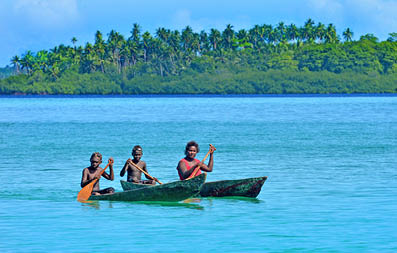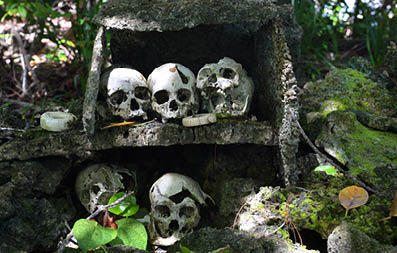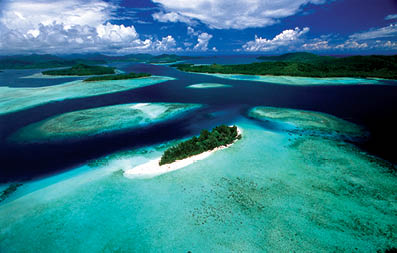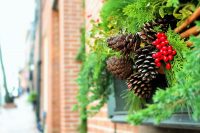Wayne Dixon
This is what travelling used to be like. Discovering something new, trying new food, living on a jungle island.
Traditions haven’t died in the Solomon Islands. This is a land where ancient is now, where life goes on uninterrupted. It is amazing that it is so close to Australia. This bustling super island of ours could learn a few things from our friendly neighbour. Relax, slow down and chill out.
The Solomon Islands are only 3½ hours from Australia, but superbly different off the beaten track & a hip new hot spot for travellers from around the world.
Honiara hugs the coastline of Guadalcanal, the largest island in the Solomon’s & the centre of trade and commerce for the region.
Honiara is a little bit port warehouse with a kind of in waiting seediness that usually precedes major refurbishment. Misunderstood by visitors & embraced by its locals & expatriates, the Solomon’s biggest city is where everyone needs to be sometime.
There is an oversupply of historic sights of significance to both the allied historian & his Japanese counterpart in Honiara. These monuments & memorials wrecks & museums are bound to stir you, as they did me. The history of this place can be an intense personal experience
WWII relics lie in wait on the sea bottom for divers to explore. Memorials to the lost are many here. The fierce battles on sea and land took place here. There is much to explore in Honiara’s history.
A colourful town of people walking, people buying and selling. Chewing the betel nut, coffee colours and red teeth smiling. The sun is hot, so thankfully there are many fine air-conditioned restaurants & coffee lounges to seek refuge. Most people have to come to Honiara to get to the other provinces, as this is a nation of 900 islands. Many have to overnight before heading to their island resort. Business men & women are here for a longer stay.
The top hotel on the savvy & business travellers list is the Heritage Park Hotel. On a waterfront location with an outdoor swimming pool & spa, this is the perfect place to relax after a day exploring the historical sites around Honiara. The rooms, suites & serviced apartments are luxuriously appointed. Most visiting dignitaries have stayed here.
The Terrace Restaurant is the place where people meet to dine at the Heritage Park. The food is outstanding, try the fish curry or ‘snapper sollies style’ a marinated snapper in coconut milk. The Renaissance/GG’s offers a more formal a la carte style of dining. You can also dine by the pool & sip an island style cocktail at Splash Bar with the sea air enlivening you.
Conferences & groups are accommodated from 10-250 at a time. The gym is where you can work off the brilliant seafood you have consumed here.
The rooms are stylishly furnished with all modern conveniences. The suites are fully equipped for all your needs. They have thought of everything to make your stay relaxed, secure & comfortable.
You will enjoy your stay in Honiara the Heritage Park Hotel, when only the best will do. Go to http://www.heritageparkhotel.com.sb/ for bookings and details.
If you’re thinking of an island holiday your next destination after Honiara should be the ecofriendly luxury Resort of Sanbis. www.sanbisresort.com.sb
To get there you fly from Honiara to Gizo, with a stop on Munda Island. The flight takes you over some spectacular scenery, so grab a window seat on the Solomon Air 18 seater plane.
Reef fringed islands below are stunning. Some have small villages others are uninhabited & there are many. The Morovo Lagoon, one of the world’s largest beams its azure gleam to all who see it.

When you land in Gizo, you will be amazed as the landing strip is on a nearby island with no road & no parking lot. Two rows of fast boats await passengers to take them to their selected resorts. Sanbis is only 5 minutes away on Mabanga Island.
Sanbis is one of the premier resorts in the Solomon Islands. Its over water restaurant is famous for the exquisite fresh seafood and its pizza.
At Sanbis you can opt to relax away your time or get involved with adventure & sports. Take a day trip to Gizo, the hub of the western province, home to a new hospital and Sollies style shops selling provisions. Its markets are along the portside of the town with red toothed betel nut salesman doing a roaring trade.
Snorkel in the stunning water over the reef in front of Sanbis or soak in the view across the lagoon. Sanbis have full day trips to the sacred Skull Island, where skulls are placed with shell money in tombs of stone. See Simbo Volcano Island a jungle island with 2 volcanic caves. Explore & get marooned on Olasana Island with snorkelling & a BBQ.
Try stand up paddle boarding, kayaking, parasailing, water skiing, knee boarding, all the on the water fun you could dream of.
Surfers are regulars at Sanbis & some staff at Sanbis are regular surfers, who will take you to the reef breaks. The three local reef breaks are only tween 7 & 20 minutes away by boat. Best time for surf is November to April, but waves can be found year round, swell permitting. Surf transfers are provided for in house guests, up to 8 in one boat.
Divers are in heaven at Sanbis. Gin clear water. Abundant marine life. Coral of intense colour. Wrecks of planes & ships from WWII.
The chain of reef around Gizo Lagoon are located near Sanbis. High catch rates & huge fish are the norm in these waters with a variety of species from plate to game. Boat charters can be arranged.
Sanbis Island Resort boasts ecofriendly bungalows right on the beach, perfect for all your needs .Look out from your private accommodation to lagoon views with magnificent islands in the background. The sky fills with starts each night & relaxed becomes your natural state. www.sanbisresort.com for bookings & details.
In this unique destination there are no high rise apartments, no take away food corporations, no international resorts, just fine, hip, rustic-lux accommodation on island seen only in your imagination. The Solomon is happening now. It is time for the Solomon’s.
15 Facts about the Solomon Islands
Fact 1
The Solomon Islands became an independent island-country on 7th July 1978.
Fact 2
In 1886, Great Britain and Germany divided the islands between them, but later Britain was given control of the entire territory.
Fact 3
United Kingdom’s protectorate over the Solomon Islands started in 1890s and ended in 1976, with attainment of self-governance by the latter.
Fact 4
The capital of Solomon Islands is Honiara located on the island of Guadalcanal.
Fact 5
The official language is English though Melanesian pidgin and 120 indigenous languages are also spoken.
Fact 6
Majority of the people in Solomon Islands are Protestants followed by Roman Catholics and others who have indigenous beliefs.
Fact 7
The currency used in this country is the Solomon Islands Dollar. It became an independent island-country on 7th July, 1978.
Fact 8
There are only two seasons in Solomon Islands: dry and raining. The rainy season is from November to April.
Fact 9
The largest of all Solomon Islands is Guadalcanal. The other significant islands are Choiseul, San Cristobal, Santa Isabel, Malaita, the Santa Cruz group and New Georgia.
Fact 10
The highest point is Mount Popomanaseu, located on the Guadacanal province at 2300 m making it an Ultra Peak (Ultra is short for ultra-prominent, the highest classification of mountain height.)
Fact 11
The world’s largest salt water lagoon – Marovo Lagoon is situated in New Georgia, Solomon Islands.
Fact 12
The major industries are fish (tuna), mining and timber. Agriculture is cocoa, coconuts, palm kernels, rice, potatoes, timber cattle, pigs and fish. The Exports are timber, fish, copra and palm oil.
Fact 13
The natural resources are fish, forests, gold, bauxite, phosphates, lead, zinc and nickel. The major trading partners are China, Thailand, Japan, New Zealand, Malaysia, Australia and Singapore.
Most people consider themselves to be part of an immediate family of 200 and can trace back their ancestors at least ten generation.
Fact 14
The Pijin word “wantok” – which derives from “one talk” meaning people from the same language group – is used to indicate blood relatives in the extended family.
Fact 15
Skull Island in Solomon Islands, is a small island located in VonaVona Lagoon that contains a headhunting shrine. The centerpiece of the shrine is an elaborately carved container that holds the skulls of the chiefs of the local village. Littered around the chief’s shrine are the skulls of the chiefs victims. A very eerie and interesting look into the headhunting days of the area.





